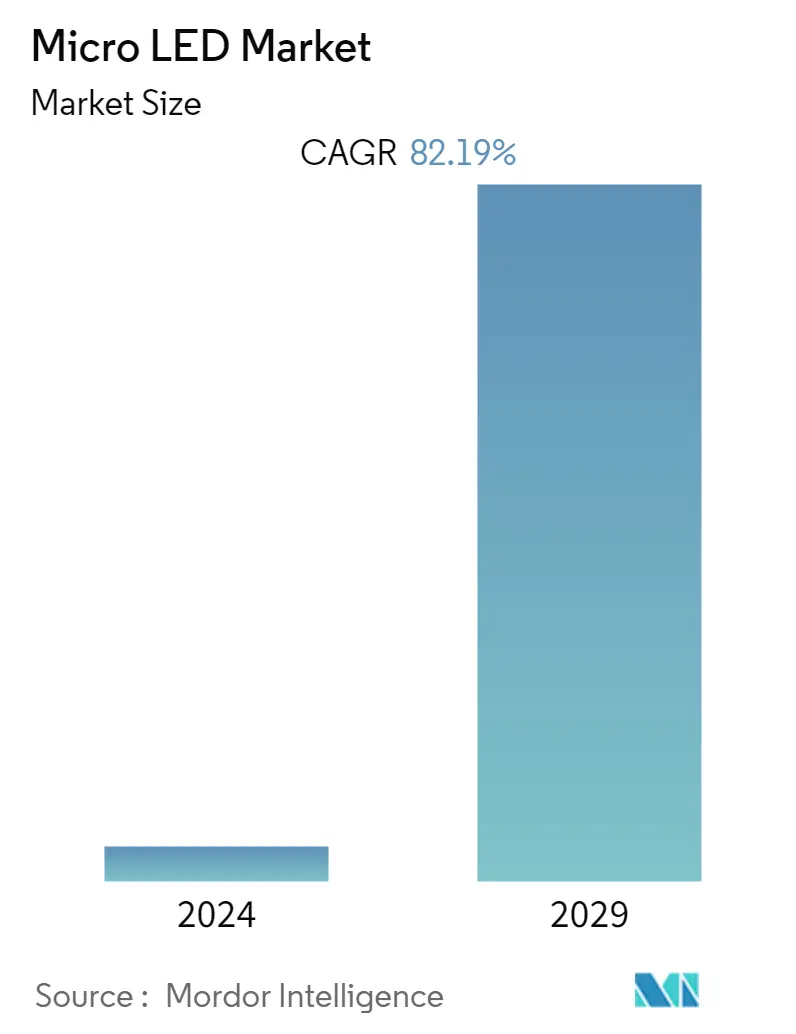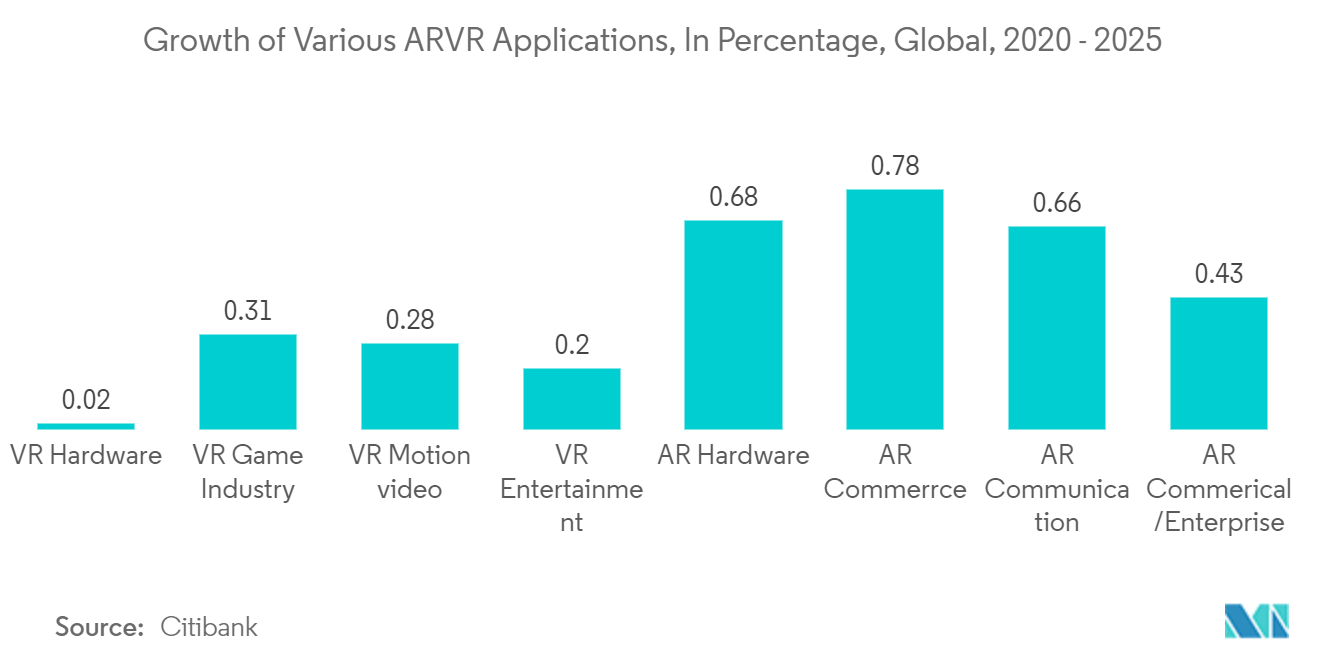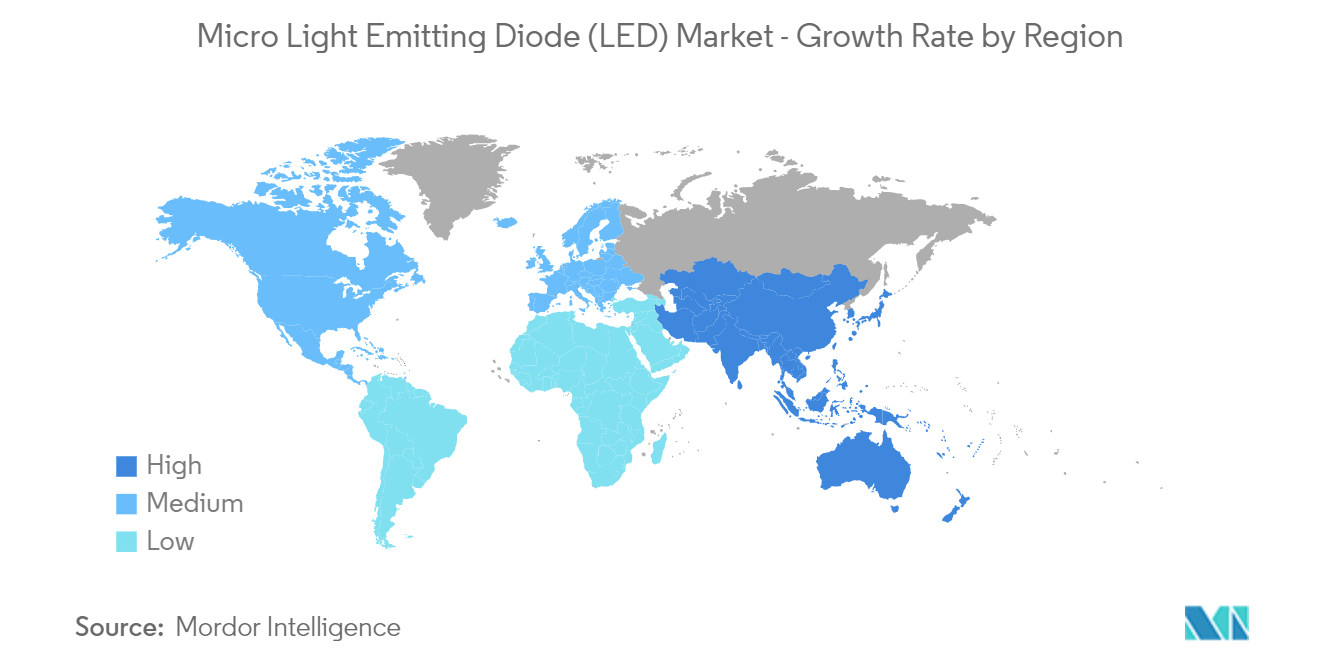Micro LED Market Size

| Study Period | 2018 - 2028 |
| Market Size (2023) | USD 1.06 Billion |
| Market Size (2028) | USD 21.29 Billion |
| CAGR (2023 - 2028) | 82.19 % |
| Fastest Growing Market | North America |
| Largest Market | Asia Pacific |
Major Players_Market_-_Major_Players.webp)
*Disclaimer: Major Players sorted in no particular order |
Need a report that reflects how COVID-19 has impacted this market and its growth?
Micro LED Market Analysis
The Micro LED Market size is expected to grow from USD 1.06 billion in 2023 to USD 21.29 billion by 2028, at a CAGR of 82.19% during the forecast period (2023-2028).
The rising growth of consumer technology coupled with an emergency of MEMS technology is further boosting the growth of the market studied.
- In the current market, liquid crystal displays (LCDs) and organic light-emitting diode (OLED) displays are the two dominant flat-panel display technologies. However, micro-LEDs (μLEDs) and inorganic mini-LEDs (mLEDs) have recently emerged by significantly enhancing LCDs' dynamic range or as sunlight-readable emissive displays.
- A micro-LED is considerably simpler than an LCD, as they emit light and can be controlled individually. This results in displays that offer significantly better image quality (response time, contrast) and are highly efficient, too, as there are no filters in LCDs. OLEDs utilize tiny sub-pixels made from organic emissive materials. Micro-LEDs are somewhat similar but with an inorganic LED structure. Compared to OLEDs, micro-LEDs are poised to be much more efficient and brighter, more durable (higher lifetime), and with a higher color gamut.
- Mini-LED and micro-LED screens have several advantages over LCD and OLED displays, such as being thinner and more energy-efficient. As a result, several companies are developing new devices that may use the latest technologies. Apple showed significant interest in incorporating micro-LED technology in its iPhone, iPad, and smartwatch display applications.
- The requirements of wearable products include small size, lightweight, low power consumption, and environmental resistance. The progressing micro-LED technologies, thus, become critical for the development of smart wearables. Micro-LED is poised to be the next-generation display for innovative applications for smartwatches and glasses. In December 2020, Konka introduced the first micro-LED Watch, the APHAEA Watch. It uses a 2-inch micro-LED display with a pixel pitch of 0.12 mm, and the micro-LED chips are 30 um in size.
- Further, rapid advances in high-speed communication and miniature mobile computing platforms escalated a strong demand for deeper human-digital interactions beyond traditional flat panel displays. AR and VR technologies are driving the growth of next-generation interactive displays with increased applications across various industries. Such trends are expected to boost micro-LED adoption for AR and VR applications.
Micro LED Market Trends
This section covers the major market trends shaping the Micro LED Market according to our research experts:
AR/VR to Account for Significant Market Share
- Virtual Reality and augmented reality technologies have redefined the way users interact with electronics and gadgets by embracing an immersive experience and promoting interaction between the user and the device. Such trends augment the demand for advanced display technologies, amongst other technologies.
- Micro-LED is an advanced display technology that ensures high brightness and contrast while keeping power consumption low. These features are particularly relevant for augmented reality (AR) and virtual reality (VR) applications to deliver the best visual experience. The increased number of applications stimulates several companies to collaborate to develop and integrate advanced technologies in their devices and enhance the user’s experience.
- In October 2021, Chinese electronics company TCL unveiled its brand-new Thunderbird Smart Glasses Pioneer Edition, equipped with a full-color transparent micro-LED display. The glasses also have an inbuilt camera allowing users to take pictures with a click on the side of the frame. The glasses look like regular specs due to their transparent displays and the waveguide technology that TCL has been using for three years. The glasses may also have augmented reality support, which means they can add layers of digital information to the user’s vision through the glasses.
- Further, in December 2021, MICLEDI Microdisplays, a technology company in micro-LED displays for high-end augmented reality (AR) glasses, demonstrated the industry’s first micro-LED arrays-for-AR built on a 300mm CMOS manufacturing platform. The advanced manufacturing precision, performance, and cost-efficiency offered by the 300mm product strategy distinguish MICLEDI as a display partner of choice for AR glasses manufacturers.
- Also, in September 2021, Xiaomi introduced a pair of smart glasses called Xiaomi Smart Glasses, equipped with a monochrome micro-LED system that provides higher pixel density and a longer lifespan while having a simpler structure compared to OLED. According to Xiaomi, micro-LED allows for a more compact display and easier screen integration.

North America to Account for Largest Share
- The increasing penetration of smartphones is considered one of the biggest contributors toward adopting micro LED in the region. In recent years, the United States witnessed consistent growth in smartphone sales. According to Zippia, around 294.15 million people in the United States own a smartphone, which is about 89% of the country's total population.
- The increasing penetration of smartwatches in the region is also expected to augment the adoption of the micro LED market. Companies, such as Google and Apple are planning to launch a new smartwatch in the United States to leverage the growing opportunities of these devices in the region. For instance, in October 2022, Google launched its first smartwatch, which will be available online and in its physical store in New York City.
- The United States Patent and Trademark Office has granted a patent for Apple Inc. for a flexible and rolling display. The company is now looking at developing a device featuring two separate housings which roll out to reveal a flat display in the center. The patent also indicates that the devices could feature both a rigid display and a rollable screen.
- Further, in May 2022, Vuzik, a United States-based manufacturer of AR smart glasses, announced an agreement with Atomistic SAS. The strategic agreement provides Vuzix with an exclusive license to use microLED lenses for its smart glasses, and Atomistic SAS will assist Vuzix in designing custom backplates for its AR products. Such developments fuel the studied market's growth over the forecast period.

Micro LED Industry Overview
The Micro Light Emitting Diode (LED) Market is highly competitive. With increased innovations and sustainable products, many companies are increasing their market presence by securing new contracts and tapping new markets to maintain their position in the global market. Some of the key developments are:
In October 2022, Avicena announced the acquisition of a microLED fabrication facility and associated engineering team from Nanosys. The transaction will significantly enhance Avicena’s capabilities in developing and manufacturing high-speed GaN microLEDs optimized for parallel multi-Tbps interconnects.
In March 2022, Google announced the acquisition of Raxium, a MicroLED-based start-up that develops tiny light-emitting diodes for displays used in augmented and mixed-reality devices. The acquisition will help Google make AR displays.
Micro LED Market Leaders
Sony Corporation
Innolux Corporation
LG Display Co. Ltd
Aledia SA
Epistar Corporation
*Disclaimer: Major Players sorted in no particular order
_Market_-_Market_Concentration.webp)
Micro LED Market News
- August 2022 - Ennostar announced an investment of NTD 3.62 billion (USD 122 million) in Epistar, its wholly owned subsidiary, to set up production capacity for 150 mm MicroLED wafer capacity expansion.
- December 2021 - MICLEDI Microdisplays announced the industry's first microLED arrays-for-AR built on a 300mm CMOS manufacturing platform. The unparalleled manufacturing precision, performance, and cost-efficiency offered by the 300mm product strategy distinguish MICLEDI as a display partner of choice for AR glasses manufacturers.
Micro LED Market Report - Table of Contents
1. INTRODUCTION
1.1 Study Assumptions and Market Definition
1.2 Scope of the Study
2. RESEARCH METHODOLOGY
3. EXECUTIVE SUMMARY
4. MARKET INSIGHTS
4.1 Market Overview
4.2 Industry Value Chain Analysis
4.3 Industry Attractiveness - Porter's Five Forces Analysis
4.3.1 Threat of New Entrants
4.3.2 Bargaining Power of Buyers
4.3.3 Bargaining Power of Suppliers
4.3.4 Threat of Substitute Products
4.3.5 Intensity of Competitive Rivalry
5. MARKET DYNAMICS
5.1 Market Drivers
5.1.1 Emergence of MEMS Technology
5.1.2 Growth of Consumer Electronics
5.2 Market Restraints
5.2.1 Mass Transfer to be a Bottleneck for Commercialization of Micro Led
5.2.2 Complexities Through the Supply Chain
6. MARKET SEGMENTATION
6.1 By Application
6.1.1 Display
6.1.1.1 Smartwatch
6.1.1.2 Near-to-eye Devices (AR and VR)
6.1.1.3 Television
6.1.1.4 Smartphone and Tablet
6.1.1.5 Monitor and Laptop
6.1.1.6 Head-up Display
6.1.1.7 Digital Signage
6.1.2 Lighting
6.2 By End User
6.2.1 Consumer Electronics
6.2.2 Automotive
6.2.3 Aerospace and Defense
6.2.4 Other End Users
6.3 By Geography
6.3.1 North America
6.3.2 Europe
6.3.3 Asia-Pacific
6.3.4 Rest of the World
7. COMPETITIVE LANDSCAPE
7.1 Company Profiles
7.1.1 Innolux Corporation
7.1.2 Sony Corporation
7.1.3 LG Display Co Ltd
7.1.4 Aledia SA
7.1.5 Epistar Corporation
7.1.6 Optovate Limited
7.1.7 Rohinni LLC
7.1.8 Samsung Electronics Co. Ltd
7.1.9 JBD Inc.
7.1.10 Plessey Semiconductors Limited
7.1.11 Ostendo Technologies Inc.
7.1.12 VueReal Inc.
7.1.13 Allos Semiconductors
- *List Not Exhaustive
8. INVESTMENT ANALYSIS
9. MARKET OPPORTUNITIES AND FUTURE TRENDS
Micro LED Industry Segmentation
Micro LED, also known as micro-LED, is an emerging flat panel display technology. As the name implies, microLED displays consist of arrays of microscopic LEDs forming individual pixel elements. When compared to the widespread LCD technology, microLED displays offer better contrast, response times, and energy efficiency.
The Micro Light Emitting Diode Market is Segmented by Application (Display (Smartwatch, Near-to-eye Devices, Television, Smartphone & Tablet, Monitor & Laptop, Head-up Display, Digital Signage), Lighting), End User (Consumer Electronics, Automotive, Aerospace & Defense), and Geography. The market sizes and forecasts are provided in terms of value (USD million) for all the above segments. The market estimates are based on the revenues accrued by vendors in the market from the sale of the considered products. The market demand, trends, dynamics, forecasts (COVID-19 adjusted), and outlook are covered under the device application and end-user sectors.
| By Application | |||||||||
| |||||||||
| Lighting |
| By End User | |
| Consumer Electronics | |
| Automotive | |
| Aerospace and Defense | |
| Other End Users |
| By Geography | |
| North America | |
| Europe | |
| Asia-Pacific | |
| Rest of the World |
Micro LED Market Research FAQs
How big is the Micro LED Market?
The Micro LED Market size is expected to reach USD 1,060.84 million in 2023 and grow at a CAGR of 82.19% to reach USD 21,294.67 million by 2028.
What is the current Micro LED Market size?
In 2023, the Micro LED Market size is expected to reach USD 1,060.84 million.
Who are the key players in Micro LED Market?
Sony Corporation, Innolux Corporation, LG Display Co. Ltd, Aledia SA and Epistar Corporation are the major companies operating in the Micro LED Market.
Which is the fastest growing region in Micro LED Market?
North America is estimated to grow at the highest CAGR over the forecast period (2023-2028).
Which region has the biggest share in Micro LED Market?
In 2023, the Asia Pacific accounts for the largest market share in the Micro LED Market.
Micro LED Industry Report
Statistics for the 2023 Micro LED market share, size and revenue growth rate, created by Mordor Intelligence™ Industry Reports. Micro LED analysis includes a market forecast outlook to 2028 and historical overview. Get a sample of this industry analysis as a free report PDF download.
